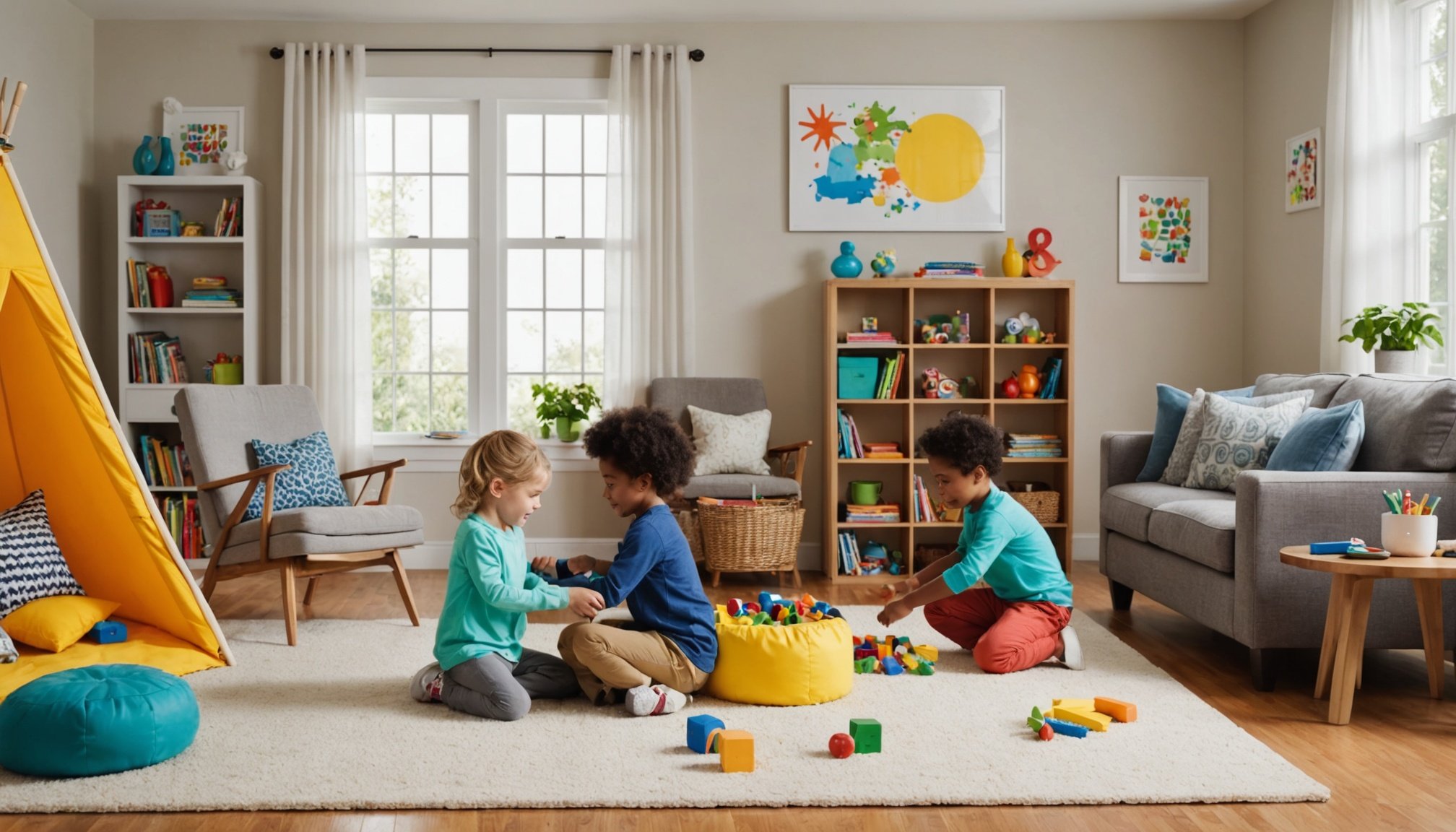Understanding the Need for Concealing Play Zones
Incorporating a children’s play area into a living room design can be a complex task. The challenge lies in balancing functionality with aesthetics, to create family-friendly spaces that don’t compromise adult living requirements.
Importance of Integration
A thoughtfully designed children’s play area can transform a living room into a multifunctional family hub. Integrating such spaces ensures that children can play freely, promoting their growth and creativity, without impinging on the room’s sophistication.
Also read : Crafting a Tranquil Zen Guest Room: Your Guide to Mindful Relaxation and Serenity
Functionality Meets Aesthetics
Home design has evolved to combine child-friendly elements with adult preferences. By selecting storage solutions and movable furniture, a living room can transition smoothly from a play zone to an adult-friendly area. This dual purpose highlights the importance of a living room design that considers varied family needs.
Balancing Needs
Balancing children’s play needs with adults’ space requirements demands creative solutions. By using versatile furniture and disguised storage spaces, the essence of a sophisticated living room is maintained while meeting children’s demands. This approach ensures a harmonious environment, encouraging both play and relaxation within the family-friendly spaces.
Also read : Creating a Secure and Fun Play Space for Toddlers in Your Cozy Apartment: A Comprehensive Guide
Creative Furniture Solutions
In the quest for optimising living spaces, multifunctional furniture proves indispensable. It seamlessly blends practicality with aesthetics, offering not just seating or surface space, but also smart storage solutions. Consider a coffee table that conceals drawers or a sleeper sofa that doubles as a guest bed. Each piece contributes to a clutter-free environment by incorporating hidden storage compartments into its design.
These design elements are not merely functional; they complement existing decor, ensuring a harmonious appeal. For instance, an ottoman with a lift-off lid can serve as both a seat and a storage unit for throws or magazines, maintaining the room’s visual sweep without sacrificing utility.
An excellent way to maintain a cohesive look is through built-in furniture, which anchors spaces with its integrated form. It seamlessly converges with your room’s architecture, often using similar materials or finishes found within the home. Built-ins, like bookcases or window seats with hidden compartments, cleverly combine form and function without intruding on the natural flow of a room.
When selecting furniture, consider the versatility it offers in both use and form. Reflect on how each item can contribute not only to style but also indispensable functionality.
DIY Concealment Techniques
Enhance your home environment effortlessly with creative crafts and DIY projects that integrate style and practicality. The following subsection will guide you through crafting and executing custom solutions that merge seamlessly with your home decor.
DIY Play Zone Curtains
Creating removable curtains for play zones is a straightforward yet effective way to enhance home improvement efforts. Begin by selecting a fabric that balances durability and aesthetics. Patterns like stripes or muted tones can match existing decor, adding a stylish touch while withstanding regular use. The installation process involves affixing curtain rods or tension rods above play areas, facilitating easy removal, and ensuring a clean finish that doesn’t disrupt the room’s flow. Using lightweight materials with reinforced stitching enhances functionality without compromising on style.
Custom Play Mats and Floors
Custom play mats offer not only a burst of creativity but a practical solution for maintaining cleanliness. Consider designs that showcase both aesthetic charm and tactile elements, encouraging imaginative play while preserving the elegance of your space. Opt for removable flooring options, like foam tiles or interconnected mats, for straightforward clean-up and effortless adaptability to any room size or shape. Offering a sensory play area while maintaining stylish decor is easily achievable with thoughtful design.
Repurposing Existing Furniture
Transform your existing shelves and cabinets into multifunctional play spaces. Consider installing sliding doors to artfully conceal these zones when not in use, maintaining your room’s aesthetically pleasing look. For efficient home improvement, adapt items already available, like repurposing a bookshelf into a mini-hideaway or crafting a play nook within a disused closet space, to enhance fun while keeping your living area tidy.
Incorporating Decorative Elements
Creating a balanced home decor that coexists with a child-friendly environment requires strategic selection of visual elements. For instance, selecting art and decorations that harmonise with children’s items can maintain style without sacrificing practicality. Opt for durable, safe materials and consider artwork mounted at an adult’s eye level, ensuring it remains out of children’s reach yet contributes to the room’s visual appeal.
To craft a visually cohesive space, it is essential to establish subtle boundaries within the living room. Dividing areas with rugs or furniture not only creates functional zones but also manages clutter. Choose rugs with gentle patterns that add charm without creating too busy an atmosphere. This approach ensures each space serves a purpose and avoids overwhelming the decor.
Integrating vibrant colors and patterns enhances the room’s aesthetics and maintains a joyful ambiance. Aim for accent walls painted in a lively hue or incorporate child-friendly designs through colourful cushions and throws. Such playful touches ensure a lively environment while preventing sensory overload.
Incorporating these techniques results in a home that balances visual appeal with child-friendly practicality, making the space inviting for both adults and children alike.
Ensuring Safety and Accessibility
Creating a secure and accessible play zone is essential for family living. Prioritising child safety involves well-thought-out design and practical measures. Use safety gates and soft padding to ensure unintentional incidents are minimised. When designing play areas, regularly check for potential hazards such as exposed electrical outlets or sharp edges. These can be easily addressed with childproof covers and corner protectors to enhance safety precautions.
Accessibility in play zones is equally critical. Ensure that toys and other playtime equipment are within easy reach. Consider open shelves at a child’s height, facilitating independent play and reducing the need for adult intervention. This not only promotes autonomy for children but also assists parents in keeping an eye on their kids without unnecessary strain.
Furthermore, maintaining ease of access for parents allows for effective monitoring during playtime. Large, open spaces can facilitate this, along with transparent partitions or baby monitors if needed.
With thoughtful planning, family living can be made more enjoyable, ensuring children can play safely and independently while parents remain reassured about their well-being.
Maintaining a Cohesive Living Room Look
When aiming for design harmony in a living room, it’s crucial to integrate play zones without disrupting the overall room cohesion. One effective strategy is to choose versatile furniture that complements the existing style. Opt for storage solutions that match your family aesthetics, such as baskets or bins that echo the room’s color palette or material finishes.
Colour coordination plays a vital role in maintaining cohesion. Select hues from your current decor for play area elements to create a seamless transition. Incorporating similar shades into play items like cushions or small furniture pieces can make the area feel like a natural extension of the living space.
Balancing playful elements with a sophisticated living room vibe requires careful consideration. Introduce playful items subtly by using sophisticated forms or textures that align with the family’s aesthetics. For instance, a sleek shelving unit can hold children’s books or toys while maintaining an orderly appearance.
The key lies in mirroring the design motifs of the living room within the play zone’s elements. By selecting elements that resonate with the core design theme, your living room can remain cohesive and stylish while accommodating the playful needs of the family.
Inspirational Visuals and Examples
Navigating through a world of design inspiration can be a visual feast. Whether you are a seasoned decorator or just beginning to explore, being exposed to a variety of visual examples is invaluable. No matter your space constraints or style preferences, these examples can transform any room into a visually appealing sanctuary.
Photo Gallery of Concealed Play Zones
When curating a collection, it’s vital to include spaces designed with creativity, offering diverse designs to complement multiple decor themes. From rustic nooks to modern minimalism, emphasis is placed on ingenious solutions, inspired by real homes, that blend seamlessly into your personal environment. These galleries serve as a foundation, allowing you to envision the possibilities within your own home and underscoring the limitless potential of home galleries.
Video Tutorials on Implementation
To truly grasp the intricacies, visual guides are crucial. Recommended video resources cater specifically to DIY enthusiasts, providing intuitive step-by-step instructions for seamlessly integrating play areas. Witnessing these concepts in action fosters a deeper understanding of their functionality and aesthetic potential, making them easier to adapt.
Design Blogs and Influencers
Exploring design blogs and influencers can further enhance your home gallery journey. Tapping into reputable sources enriches your knowledge base; interior designers provide expert advice, while social media channels serve as a hub for evolving ideas and trends, ensuring your inspiration is constantly refreshed.











